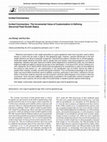Papers by Camille H Raynes-Greenow

Birth defects research. Part A, Clinical and molecular teratology, Jan 16, 2015
Poor sleep has been studied in relation to various diseases. Few studies have investigated the ef... more Poor sleep has been studied in relation to various diseases. Few studies have investigated the effect of poor sleep on birth defects. We examined the association of maternal poor sleep during periconceptional period and the risk of neural tube defects (NTDs) in offspring based on a large case-control study in northern China. The subjects included 629 NTD cases and 858 normal controls investigated between 2002 and 2007. Maternal sleep status was collected by health workers within first week after delivery. Logistic regression was used to estimate the odds ratio (OR) and 95% confidence interval (CI) of NTDs in association with poor sleep. The proportion of mothers with frequent poor sleep (≥4 days/week on average) was markedly higher in NTDs group (5.9%) than in control group (1.2%). In the multivariate analysis, frequent poor sleep was significantly associated with an increased risk of total NTDs (adjusted OR, 4.1; 95% CI, 1.9-8.8) and spina bifida subtype (adjusted OR, 6.4; 95% CI, ...

PLOS ONE, 2016
Iron deficiency Anemia (IDA) in children is a recognized public health problem that impacts adver... more Iron deficiency Anemia (IDA) in children is a recognized public health problem that impacts adversely on child morbidity, mortality and impairs cognitive development. In Pakistan information on the true prevalence and predictors of IDA is limited. This study sought to investigate IDA in children under five years of age using data from a nationally representative stratified cross-sectional survey. Secondary analysis was performed on the National Nutrition Survey in Pakistan 2011-2012. We used a pre-structured instrument to collect socio demographic and nutritional data on mothers and children. We also collected Anthropometric measurements and blood samples for micronutrient deficiencies. IDA was defined as having both haemoglobin levels of <110 g/L and ferritin levels of < 12 μg/L. Data analysis was performed by applying univariate and multivariate techniques using logistic regression through SPSS. A total of 7138 children aged between 6-59 months were included in the analysis. The prevalence of IDA was 33.2%. In multivariate regression analysis adjusted odds ratios (AOR) were calculated. Age < 24 months (AOR 1.40, 95% CI 1.18-1.55 p <0.05), stunting (AOR 1.42 CI 1.23-1.63 p<0.05), presence of clinical anemia (AOR 5.69 CI 4.93-6.56 p<0.05), having a mother with IDA (AOR 1.72 CI 1.47-2.01 p<0.05) and household food insecurity (AOR 1.20 CI 1.10-1.40 P<0.05) were associated with IDA. Living in a rural area (AOR 0.77 CI 0.65-0.90 p<0.05) and being a female child (AOR 0.87 CI 0.76-0.98 p<0.05) were associated with reduced odds of IDA. The prevalence of IDA amongst Pakistani children represents a moderate burden that disproportionately affects the youngest, growth retarded children, affected children are more likely to have mothers with IDA and live in areas where food security is lacking. National efforts to alleviate the burden of IDA should involve both short term vertical programs such as iron supplementation and long term horizontal programs including wheat flour fortification.

Birth Defects Research Part A: Clinical and Molecular Teratology, 2015
Only two population-based studies have reported survival beyond 15 years for individuals with oro... more Only two population-based studies have reported survival beyond 15 years for individuals with orofacial clefts (OFC), and only for individuals with isolated OFC. Compared with the general population, long-term survival was similar for individuals with cleft lip only, and lower for individuals with cleft palate only. Results for those born with isolated cleft lip and cleft palate were inconsistent. Using linked population-based health data, including a congenital anomaly register with active surveillance and diagnoses up to 6 years, we compared survival at 1, 5, and 20 years for infants born 1980 to 2010 with, and without OFC. Of the 8112 live born infants in the cohort, 186 died before 20 years; most (81%) died during infancy. Compared with infants without OFC, infants born with all types of isolated OFC ± additional minor anomalies had similar infant survival (around 99%), but we found lower survival for infants with all cleft types and an additional major anomaly (66-84%). From 1 to 5 years, only infants with cleft palate only and an additional major anomaly had lower survival (97%) compared with children without OFC (99.9%). From 5 to 20 years, children with all cleft types, with or without additional major anomalies had similar survival to children without OFC (98-100%). Parents with a child diagnosed with an OFC ± additional minor anomalies only can be reassured that the OFC does not influence survival rates in infancy, or long-term. Infant survival was lower only for children with OFC and additional major anomalies. Birth Defects Research (Part A), 2015. © 2015 Wiley Periodicals, Inc.

Journal of Paediatrics and Child Health, 2015
The aim of this study was to compare hospital admissions from infancy to adulthood, between child... more The aim of this study was to compare hospital admissions from infancy to adulthood, between children born with orofacial clefts (OFC) and those without OFC. The method used was a cohort study using record-linked administrative datasets. Participants included all children liveborn in Western Australia (WA) between 1980 and 2010 diagnosed with OFC, who were frequency matched by year of birth to randomly selected liveborn children without OFC. We calculated rate ratios (RR) of hospital admission, number and reason of admissions, cumulative length of stay, for each cleft type (cleft lip only (CLO), cleft lip and palate (CL+P), cleft palate only (CPO), no OFC) and by age period (infancy, pre-school, primary and high school ages, and early adulthood). Overall, 1396 children were diagnosed with an OFC and compared with 6566 children without OFC. Individuals born with OFC were up to three times more likely to be admitted to hospital, had more admissions and longer cumulative length of stay in all age periods. Children with OFC were also more likely to be admitted for ear and digestive system conditions (RR up to 30 and six times higher, respectively). Children with CL+P and CPO were more likely to be admitted for respiratory conditions (RR 1.3-2.0) and children with CPO were six times more likely to be admitted for care for other congenital anomalies. Throughout childhood, individuals born with OFC were more likely to be admitted, and had more hospitalisations than those without OFC. Children born with CL+P or CPO had a higher hospitalisation burden than children born with CLO.

Reference tools based on birth weight percentiles at a given gestational week have long been used... more Reference tools based on birth weight percentiles at a given gestational week have long been used to define fetuses or infants that are small or large for their gestational ages. However, important deficiencies of the birth weight reference are being increasingly recognized. Overwhelming evidence indicates that an ultrasonographybased fetal weight reference should be used to classify fetal and newborn sizes during pregnancy and at birth, respectively. Questions have been raised as to whether further adjustments for race/ethnicity, parity, sex, and maternal height and weight are helpful to improve the accuracy of the classification. In this issue of the Journal, Carberry et al. (Am J Epidemiol. 2013;178(XX):XXXX-XXXX) show that adjustment for race/ethnicity is useful, but that additional fine tuning for other factors (i.e., full customization) in the classification may not further improve the ability to predict infant morbidity, mortality, and other fetal growth indicators. Thus, the theoretical advantage of full customization may have limited incremental value for pediatric outcomes, particularly in term births. Literature on the prediction of short-term maternal outcomes and very long-term outcomes (adult diseases) is too scarce to draw any conclusions. Given that each additional variable being incorporated in the classification scheme increases complexity and costs in practice, the clinical utility of full customization in obstetric practice requires further testing. birth weight; customization; fetal growth; large for gestational age; small for gestational age Abbreviations: LGA, large for gestational age; SGA, small for gestational age.
New England Journal of Medicine
Conclusions After prolonged infection with this attenuated strain of HIV-1, there is evidence of ... more Conclusions After prolonged infection with this attenuated strain of HIV-1, there is evidence of immunologic damage in three of the four subjects with detectable plasma HIV-1 RNA. The CD4 lymphocyte counts appear to be stable in the three subjects in whom plasma HIV-1 RNA remains undetectable. (N Engl

Journal of paediatrics and child health, Jan 14, 2015
Cytomegalovirus (CMV) is an important cause of congenital infection, which can result in neonatal... more Cytomegalovirus (CMV) is an important cause of congenital infection, which can result in neonatal deaths or contribute to deaths in later childhood. Post-natally acquired CMV is a less common cause of disease and mortality, and only in preterm infants or immunocompromised children. Here we sought to describe CMV as a direct or secondary contributor to childhood mortality in Australia. We searched national mortality data sets between1999 and 2011 for cases <15 years with CMV recorded as an underlying or contributing cause of death. Eighty-three CMV-associated deaths in children <15 years were identified (0.2 cases per 100 000 <15 years; 95% confidence interval 0.16-0.24). Childhood deaths associated with CMV were evenly distributed between males and females, and the majority (n = 57; 68%) occurred in children less than 12 months of age, with 22 cases <1 month of age. Over the 13-year study period, the mortality rate remained stable and CMV resulted in an estimated age-adj...

Infectious disorders drug targets, Jan 20, 2015
Congenital cytomegalovirus (cCMV) is a contributing cause of neurodevelopmental disabilities incl... more Congenital cytomegalovirus (cCMV) is a contributing cause of neurodevelopmental disabilities including cerebral palsy (CP). In this case series we reviewed the neuroimaging findings of children with CP and cCMV infection in the context of the children's clinical profile. Children with CP and laboratory confirmed cCMV (n=12) reported to the Australian CP Register, born South Australia and Victoria, 1993-2006, with magnetic resonance imaging (MRI) and/or computerized tomography (CT) report available. Clinical details and neuroimaging findings were tabulated and compared to published literature. Children in this series were mostly born at term (n=8), with symptoms or signs of cCMV (n=10) and had spastic quadriplegia (n=9), epilepsy (n=8), intellectual (n=12), communication (n=10) and hearing impairments (n=9). All but one had abnormal neuroimaging findings reported on MRI or CT (n=11): most commonly brain malformations including disorders of neuronal migration (n=10), such as lisse...
Cancer Epidemiology Biomarkers & Prevention, 2010
... (20) and Canfield et al. (21) were not included because their samples were the same as those ... more ... (20) and Canfield et al. (21) were not included because their samples were the same as those of Shu et al. (26) and Ross et al. (36), respectively. ... Abstract/FREE Full Text. ↵: Ries LAG,; Smith MA,; Gurney JG,; et al. Smith MA,; Gloeckler-Ries LA,; Gurney JG,; Ross JA. . Leukemia. ...

Developmental Medicine & Child Neurology, 2014
Congenital cytomegalovirus (cCMV) infection can result in poor outcomes including cerebral palsy ... more Congenital cytomegalovirus (cCMV) infection can result in poor outcomes including cerebral palsy (CP). The aim of this study was to describe the incidence and comorbidities of CP reported to the Australian Cerebral Palsy Register (ACPR) as attributed to cCMV infection. This was a retrospective population-based study. Cases were drawn from Australian state CP registers with population level ascertainment, 1993 to 2003 (n=2265; 56.4% males, Gross Motor Function Classification System [GMFCS] ratings available for Victorian cases only: 70% GMFCS levels I to III and 30% GMFCS levels IV to V). Clinical data were extracted and cases with cCMV reported as a known cause were compared with cases where cCMV was not reported. Children with cCMV (n=34; 12 males, 22 females; mean [SD] gestational age, 36.4 wk [4.4], range 24-41 wk) accounted for 1.5% of CP cases; 2.9 per 100,000 live births, (95% confidence intervals 1.9-3.9). When compared with CP cases where cCMV was not reported, proportionally, more CP cases with cCMV were born to younger mothers (p&amp;amp;amp;amp;amp;amp;amp;amp;amp;amp;amp;amp;amp;amp;amp;amp;amp;amp;amp;amp;amp;amp;amp;amp;amp;amp;amp;amp;amp;amp;amp;amp;amp;amp;amp;amp;amp;amp;amp;amp;amp;amp;amp;amp;amp;amp;amp;amp;amp;amp;amp;amp;amp;amp;amp;amp;lt;0.001), were female (64% vs 43%, p=0.014), had spastic quadriplegia (73% vs 21%, p&amp;amp;amp;amp;amp;amp;amp;amp;amp;amp;amp;amp;amp;amp;amp;amp;amp;amp;amp;amp;amp;amp;amp;amp;amp;amp;amp;amp;amp;amp;amp;amp;amp;amp;amp;amp;amp;amp;amp;amp;amp;amp;amp;amp;amp;amp;amp;amp;amp;amp;amp;amp;amp;amp;amp;amp;lt;0.001), required wheeled mobility i.e. GMFCS IV or V (78% vs 28%, p&amp;amp;amp;amp;amp;amp;amp;amp;amp;amp;amp;amp;amp;amp;amp;amp;amp;amp;amp;amp;amp;amp;amp;amp;amp;amp;amp;amp;amp;amp;amp;amp;amp;amp;amp;amp;amp;amp;amp;amp;amp;amp;amp;amp;amp;amp;amp;amp;amp;amp;amp;amp;amp;amp;amp;amp;lt;0.001), had epilepsy (70% vs 30%, p&amp;amp;amp;amp;amp;amp;amp;amp;amp;amp;amp;amp;amp;amp;amp;amp;amp;amp;amp;amp;amp;amp;amp;amp;amp;amp;amp;amp;amp;amp;amp;amp;amp;amp;amp;amp;amp;amp;amp;amp;amp;amp;amp;amp;amp;amp;amp;amp;amp;amp;amp;amp;amp;amp;amp;amp;lt;0.001), deafness (40% vs 2%, p&amp;amp;amp;amp;amp;amp;amp;amp;amp;amp;amp;amp;amp;amp;amp;amp;amp;amp;amp;amp;amp;amp;amp;amp;amp;amp;amp;amp;amp;amp;amp;amp;amp;amp;amp;amp;amp;amp;amp;amp;amp;amp;amp;amp;amp;amp;amp;amp;amp;amp;amp;amp;amp;amp;amp;amp;lt;0.001), functional blindness (20% vs 5%, p&amp;amp;amp;amp;amp;amp;amp;amp;amp;amp;amp;amp;amp;amp;amp;amp;amp;amp;amp;amp;amp;amp;amp;amp;amp;amp;amp;amp;amp;amp;amp;amp;amp;amp;amp;amp;amp;amp;amp;amp;amp;amp;amp;amp;amp;amp;amp;amp;amp;amp;amp;amp;amp;amp;amp;amp;lt;0.001), and severe communication impairment (71% vs 25%, p&amp;amp;amp;amp;amp;amp;amp;amp;amp;amp;amp;amp;amp;amp;amp;amp;amp;amp;amp;amp;amp;amp;amp;amp;amp;amp;amp;amp;amp;amp;amp;amp;amp;amp;amp;amp;amp;amp;amp;amp;amp;amp;amp;amp;amp;amp;amp;amp;amp;amp;amp;amp;amp;amp;amp;amp;lt;0.001). cCMV is an important potentially preventable cause of CP and is associated with severe disability and female sex in cases reported to the ACPR. Future studies utilising prospective sample collection for cCMV testing are needed to confirm these findings.

Birth, 2011
In the context of rising rates of postpartum hemorrhage and little data about its effect on wom... more In the context of rising rates of postpartum hemorrhage and little data about its effect on women, this study aimed to describe the experiences of care, and the concerns and needs of women after a significant postpartum hemorrhage. A cohort of 206 women with a primary postpartum hemorrhage of 1,500 mL or more and/or a peripartum fall in hemoglobin concentration to 7 g/dL or less and/or of 4 g/dL or more was recruited from 17 major hospitals in Australasia. Women rated their satisfaction with care and provided written responses to questions in postpartum questionnaires completed in the first week and at 2 and 4 months postpartum. In relation to care in hospital, consistently over 20 percent women responded that their needs for information, acknowledgment, and reassurance were only met sometimes, rarely, or never. Sixty-two percent reported that they were given adequate information about their likely physical recovery, and 48 percent about their likely emotional recovery. Four major themes were identified in response to the open-ended questions: adequacy of care, emotional responses to the experience, implications for the future, and concerns for their baby. This study is an important step in identifying the negative impact of experiencing a significant postpartum hemorrhage during childbirth for women who survive. Our results suggest that health professionals should pay greater attention to these women&amp;amp;amp;amp;amp;amp;amp;amp;amp;amp;amp;amp;amp;amp;amp;amp;amp;amp;amp;amp;amp;amp;amp;amp;amp;amp;amp;amp;amp;amp;amp;amp;amp;amp;amp;amp;amp;amp;amp;amp;amp;amp;amp;amp;amp;amp;amp;amp;amp;amp;amp;amp;amp;amp;amp;amp;amp;amp;amp;amp;amp;amp;#39;s informational and emotional needs.

The Medical journal of Australia, Jan 2, 2009
To assess the change in birth rates, both overall and in age, parity, socioeconomic and geographi... more To assess the change in birth rates, both overall and in age, parity, socioeconomic and geographical subgroups of the population, after the introduction of the Baby Bonus payment in Australia on 1 July 2004. Population-based study using New South Wales birth records and Australian Bureau of Statistics population estimates for the period 1 January 1997 - 31 December 2006. All 853 606 women aged 15-44 years with a pregnancy resulting in a birth at > or = 20 weeks' gestation or a baby > or = 400 g birthweight. Change in birth rate in 2005 and 2006 compared with the trend in birth rates before the introduction of the Baby Bonus. The crude annual birth rate showed a downward trend from 1997 to 2004; after 2004 this trend reversed with a sharp increase in 2005 and a further increase in 2006. All age-specific birth rates increased after 2004, with the greatest increase in birth rate, relative to the trend before the Baby Bonus, being seen in teenagers. Rates of first births were ...
Australian & New Zealand Journal of Obstetrics & Gynaecology, 2003
To assess current practices in the labour management of low risk primiparous women with epidural ... more To assess current practices in the labour management of low risk primiparous women with epidural analgesia we surveyed delivery suites in New South Wales (NSW) that annually provide at least 100 epidurals to 'standard primipara'. Epidural rates among 'standard primipara' at these hospitals ranged from 14 to 85% (median 46%). Continuous epidural infusion was the most commonly used technique (63%). For 'standard primipara' with an epidural 62% of units usually augmented labour with oxytocin, 89% discontinued the epidural in second stage and 67% had policies of delayed pushing. There is wide variation in epidural availability and in labour management, perhaps reflecting the limited evidence for effective interventions to reduce any unintended effects of epidural analgesia.
Midwifery, 2002
Objective: to assess the effect of suture materials (an absorbable synthetic suture material vers... more Objective: to assess the effect of suture materials (an absorbable synthetic suture material versus catgut) used in perineal repairs undertaken by midwives who had been trained and accredited in repair techniques.Design: randomised controlled trial.Setting: tertiary obstetric hospital in Australia.Participants: 391 women with a live singleton birth at ≥34 weeks gestation, resulting from a spontaneous vaginal delivery and who required perineal
Bjog-an International Journal of Obstetrics and Gynaecology, 2007
Objectives To evaluate the effectiveness of a decision aid for women with a breech presentation c... more Objectives To evaluate the effectiveness of a decision aid for women with a breech presentation compared with usual care.
Obstetrical & Gynecological Survey, 2004
Aim: To assess current obstetric practice in the management of singleton breech pregnancies in Au... more Aim: To assess current obstetric practice in the management of singleton breech pregnancies in Australia and New Zealand.
Australian & New Zealand Journal of Obstetrics & Gynaecology, 2003
Objective: To assess the change in birth rates, both overall and in age, parity, socioeconomic an... more Objective: To assess the change in birth rates, both overall and in age, parity, socioeconomic and geographical subgroups of the population, after the introduction of the Baby Bonus payment in Australia on 1 July 2004. Design and setting: Population-based study using New South Wales birth records and Australian Bureau of Statistics population estimates for the period 1 January 1997 -
Objective: To determine whether the proportion of babies born large for gestational age (LGA) in ... more Objective: To determine whether the proportion of babies born large for gestational age (LGA) in New South Wales has increased, and to identify possible reasons for any increase. Design and setting: Population-based study using data obtained from the NSW Midwives Data Collection, a legislated surveillance system of all births in NSW. Participants: All 1 273 924 live-born singletons delivered at











Uploads
Papers by Camille H Raynes-Greenow